by Winding Pathways | Mar 28, 2024 | Water Resources, Water Resources
(reworked from Iowa’s Wildside Column 8-27-1989)
“When will they ever learn…?” the refrain from Pete Seeger’s song circled in my mind as I reviewed columns, I wrote for the Cedar Rapids Gazette. One stood out. Iowa’s rivers and their then deteriorating condition.
Old Issue Newly Revisited
Over the past 18 months, The Gazette’s environmental writer, Brittney Miller, has addressed Iowa’s poor water quality and its impact on aquatic life.
Ah, yes, when WILL we ever learn? This is a revisit of my column from 30+ years ago.
Iowa is embraced by two of North America’s mightiest rivers – the Missouri and the Mississippi. An interesting network of streams feeds them. The height of land that divides the two drainages follows a barely perceptible rise along a northwest-southeast ridge in the western quarter of the state.
“Let The Rivers Run”
As though Paul Bunyon drew his fingers through Iowa’s geological sandbox, the major tributaries line up in roughly parallel lines flowing southeast to the Mississippi and southwest to the Missouri.
Native Americans and settlers followed these rivers. Later, steamboats, loaded with farm equipment, household goods, and finery pushed their way upstream to then bustling communities. As Iowa’s agricultural economy boomed, grist mills appeared. Farmers exported their grains to Eastern cities along Iowa’s waterways. Emerging railroads and silting waterways hastened the demise of mills. Then, hydropower proved profitable until coal and nuclear power took over.
“Managing” Water
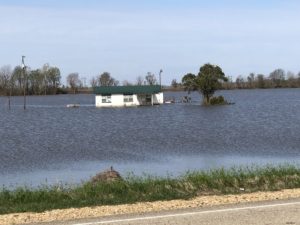
A typical spring scene in the South. Homes under water.
Earliest settlers cussed the Missouri for being too thin to plow and too thick to drink. They couldn’t tolerate its unruly, flood-prone behavior so Congress authorized channeling it with the “Missouri River Stabilization and Navigation Project.” Today, the Missouri is mostly an emasculated drainage ditch – until it rebels and reveals its power, as it has done in recent years.
Consequences
Gone are the oxbows, meanders, belt of trees, and diverse wildlife. Iowans value farmland over natural riparian habitats beneficial to mammals, birds, reptiles, insects, and aquatic life. Oh, and us!
Mighty Mississip
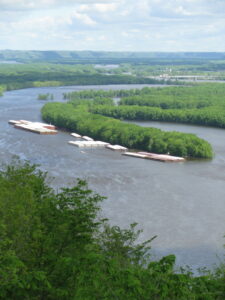
The Mississippi River stretches from Minnesota to the Gulf Coast.
The Mississippi River was dammed and dredged to provide sufficient depth for barge traffic. The dams did create numerous backwaters that support wildlife, but the Great River cannot flush itself out, so it chokes in its own silt. That toxic-laden silt slides downstream poisoning the Gulf and disrupting commercial fisheries there.
What Floodplains Do
Flood plains are areas for all wild and roiling rivers to spend their energy. The dissipated water helps recharge wetlands, and cleanses and naturally replenishes groundwater supplies. Sediment filters out on flood plains, enriching the soil.
Again and Again and Again
As we build and rebuild on flood plains, we keep spending untold dollars trying to conquer the natural elements. As residential, industrial, and agricultural demand for water increases, we rely more heavily on groundwater. That source is stressed, too. The multi-year droughts Iowa has experienced have impacted the aquifers. Lower water tables and tainted water supplies result.
When WILL we learn that our water supplies are important and to treat them respectfully and carefully?
by Winding Pathways | Jan 25, 2024 | Nature, Reflections/Profiles
Lots to Experience in January
(reworked from the Patterson’s “Iowa’s Wild Side” column
originally in the Cedar Rapids Gazette)
Winter in Iowa is erratic. Mild. January thaws. Grey, damp, and achy mornings. Frigid. Blustery. Sunny, sparkling days when all is right. We have it all. Here are ways we a find joy in January.
Some people escape to warmer regions. Most of us hang tough and grumble. At Winding Pathways, we’ve found that simple observations can enliven and deepen our appreciation for the change of seasons.
Sit Still
Bundled up in his Carharts and sitting quietly downwind at dusk, Rich notices deer begin to move. Stars and planets glow. Five geese honk and wing across the waxing moon. A photographer’s dream. An owl’s call fills the stillness left behind.
Wildlife freeze as the great horned owl’s ghostly shape floats silently to a branch near our home. Puffed to twice its size, a buffer against the cold, it waits. Several long minutes pass. Then, a rabbit cautiously emerges from the prairie stubble. An opossum noses hungrily at the compost heap. A startled mouse scurries across an open space. With talons extended and yellow eyes gleaming, the owl drops. After a brief scuffle, only bits of fur remain.
-
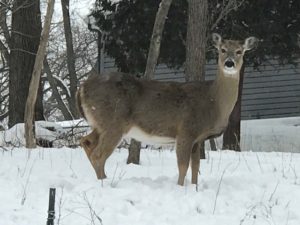
-
Inquisitive doe.
-
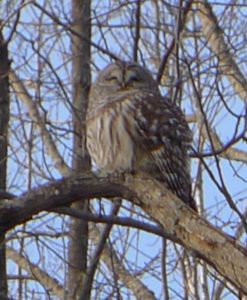
-
Waiting
-
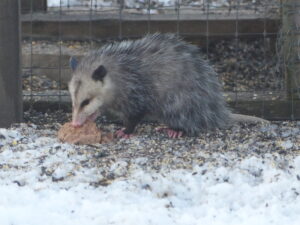
-
Possums’ feet help it climb.
Observe When You Drive
Another way we find Joy in January is by taking drives. Across a frosty Iowa road, we slow as four deer race across a field, leap a barbed wire fence, and dash to safety beyond busy Highway 30. We speculate what startled them. A short time later we observe a face-off between a grazing cow and a foraging hawk. Neck stretched out, nose to the wind, the cow eyes the hovering hawk.
From the comfort of our home, we watch birds. Siskins, when the weather is cold, Carolina wrens when winters are mild, hang around the feeder and shrubs loaded with berries. A red-headed woodpecker pecks at suet. It rattles noisily and jabs its lance-like bill at the less aggressive birds. Its strong bill is great for hammering insects out of frozen trees and pounding holes in ice-encased water baths.
January Ice
Black ice is another winter phenomenon. While not fun to drive on it is intriguing on rivers, ponds, and lakes. One Kansas winter an Arctic airmass plunged into the heartland and gave us a chance to peer into the dark depths below. A snapping turtle slowly swam through the thick water. Ice skaters reveled in the unusual event.
Nowadays we enjoy Arctic air from the inside. A small pool is just outside our window near the feeders. Sometimes, when temperatures drop quickly, and black ice forms we can see “through the looking glass” so to speak. A small aerator keeps a circle of water open. Small birds hop to the edge and drink. The overwintering goldfish appreciate the extra O2.
And we enjoy hot chocolate during January’s dormant month.
by Winding Pathways | Nov 16, 2023 | Nature, Travel/Columns
Lynyrd Skynyrd Tribute
“Sweet Home Alabama” by Lynyrd Skynyrd is a “heartfelt tribute to the state of Alabama.” Adopted by Alabama tourism as its slogan the “catchy” phrase indeed speaks to the variety and comfort of this truly Southern Hospitality state.
On a hot and muggy September trip to the deep South, we experienced Alabama hospitality and diversity from north to south.
Surprising Diversity
The northern third of Alabama is rugged where the Appalachian Mountains swing in from the northeast and finger down southwest toward the center of the state. The Tennessee River flows from Knoxville, TN, then cuts northwest through Huntsville and Decatur and on into the Tennessee Valley Authority. It’s wet there and tent camping is an adventure when the waters run high. We quickly learned that most of the waterways flow south and spill eventually into the Gulf. Planning our crossings was important because there are limited bridges from west to east.
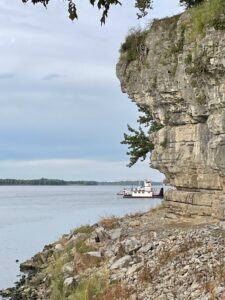
Quick way to cross the Ohio
Further north we did ferry across the Ohio at Cave in Rock, IL. This working ferry gets local and distance travelers across the broad river. The sounds of the ferry clanging and moaning of chains and engines at night recalled Jurassic Park! Then we wound our way through Kentucky and Tennessee to Alabama following parts of the Natchez Trace and the Trail of Tears.
Geologically, the ancient Appalachians of northern Alabama boast caverns, natural bridges, and tumbling waterways with falls. Cooler mountain air and vistas delight weary travelers’ eyes.
Birders find diverse birding from the endangered Red-cockaded Woodpecker that thrives in mature pine forests to the Bald Eagles that seem to soar everywhere nonplussed by humans. Nearer the coast migrating birds rest from their long flight over the Gulf. The State promotes varied birding trails.
Culturally, The Poarch Creek Indians hold Alabama sacred and are the only federally recognized Indian Tribe in the state. The Helen Keller home in Sheffield and Huntsville’s U.S. Space and Rocket Center are great stops.
This unusual phrase refers not to martial arts but to fertile calcareous soils that span central Alabama. Here, farming in plantations dominated. This region is also where the Civil Rights movement of the ‘60s. Montgomery hosts the new Legacy Museum that powerfully retells the story of kidnapped Africans who became slaves on plantations and the unjust, centuries-long suppression and incarceration of people. Along with The National Memorial for Peace and Justice, this important, interactive museum holds accountable past injustices and opens the door for reconciliation and cultural change where we ALL can be better people.
-
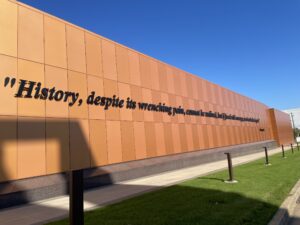
-
A sober and important museum of history.
-

-
Blend of new and old
The Coastal Shores
The drive through large swaths of timber-harvested pine forests revealed a source of the nation’s telephone poles. So, thank Alabama’s logging industry the next time you pass a pole. Our destination was Gulf Shores State Park and Lodge where we explored for three days. The Lodge is LEED certified and surrounding modern “cabins” and RV camping accommodate most budgets. How smart of the state to get this piece of Gulf land. It is one of the few areas not privately developed and with views of the Gulf waters. With miles of bicycle trails, fresh, brackish, and salt-water areas, and white sugar sand beaches, it is totally enjoyable. The habitat changes in a short distance depending on elevation (yes there is elevation along the coast) and proximity to the Gulf. We bicycled past freshwater ponds, palmetto areas, oak knobs, and back to beach habitat.
Lots for most people to take in. Our favorite was walking after dark along the shore looking for the ghost crabs. Herons stalked nearby, also on the hunt. Dawn found us sitting quietly along with others watching the sun rise over the Gulf. Each day crews set out and took in beach chairs and umbrellas. Flags flutter in strategic places alerting visitors to water conditions. During our stay, small yellow flags rippled in stiff winds. Rip currents are a thing to pay attention to.
-
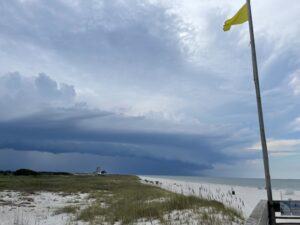
-
Weather changes rapidly along the Gulf.
-
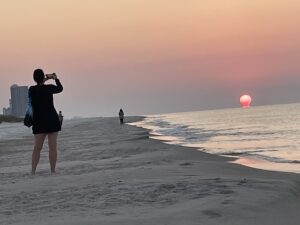
-
Quiet time at sunrise in Sweet Home Alabama
-
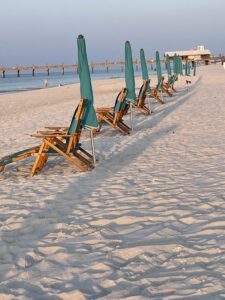
-
Ready for beach goers.
Rich took in a day fishing trip out of sight of land learning more about Gulf waters, sea bed, and the fishing industry. Marion took in oyster harvesting. Owners of Admiral Shellfish and Navy Cove shared the aquaculture techniques to raise oysters from pinpoint size to eating size in a matter of months. In northern waters, it’s years before edible oysters can be harvested. We both enjoyed several meals of oysters – who got the raw end of the deal!
-
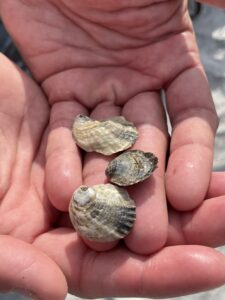
-
Gulf oysters
-
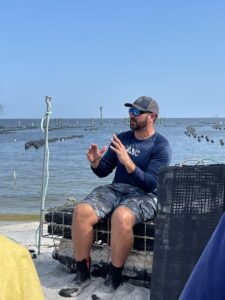
-
Protected waters make excellent habitat for oysters.
Lodging & FOOD!
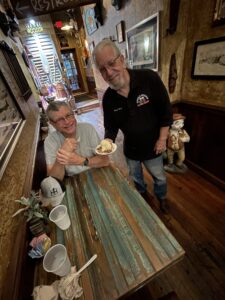
Uncle Mick’s Cajun old town Prattville is THE place to eat Southern.
We can’t say enough about Sweet Home Alabama hospitality and food. The front desk staff at the Hampton Inn and Suites, Prattville, AL, are some of the most friendly, efficient, and kind service workers we have ever met. They guided us to Uncle Mick’s Cajun just down the road in old town Prattville. The unique and tasty dishes and personal touches by the owner made the meal memorable. Staff kept dishing up small portions of truly Southern food for us to try and then loaded on our choices. Uncle Mick himself visited and drawled, “Would you like the pecan pie warmed up?” Well, yes. “How about a scoop of our local vanilla ice cream?” Well, yes. “And we’ll pour over warm bourbon sauce. If you’d like.” Well, YES! All at no extra charge. Amazing!
At Gulf Shores, the Flying Harpoon is truly local. Unpretentious, funky, and busy! Eating our po boys, and shrimp baskets, and sipping a local brew we chatted with servers and residents. Down the road tourists dined at the “recommended” upscale restaurants.
One of our most curious adventures was the luxury RV water park Tropic Falls at OWA. Not much natural there, but a great time watching huge buckets fill with water and splash down soaking nearby visitors. It was hot so that was fine! Tropical falls and dizzying roller coaster rides were two hits along with mermaids serving beverages and food. Quite the place. Be ready to spend money.
Back up through pine forests, skirting rivers, crossing the Ohio and Mississippi Rivers, and on into familiar Midwest terrain. We carry memories and stories with us.
by Winding Pathways | Nov 2, 2023 | Travel/Columns
West to Montana
This September, after a more normal Cedar Rapids year (post-derecho, post-COVID, post-surgeries) we headed to the American Prairie Reserve in Montana which we help support. Our compact equipment fit nicely in the Subaru as we headed out on Highway 30. That gave us a great view of wind turbines, especially in western Iowa. We threaded our way up to and through Sioux City to I-90 and crossed South Dakota, pausing at eye-catching rest stops.
The Badlands were smoky from Canadian wildfires the first night we camped but cleared some by the next morning. The spacious tent sites were pleasant, and our lifetime National Park senior passes came in handy.
-
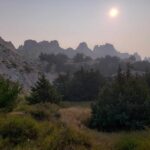
-
Canadian wildfire smoke.
-
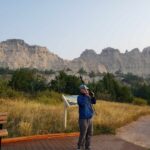
-
Smoke drifted off overnight.
-

-
Author “visiting” with wooden Wall Drug statue.
We enjoyed the Badlands loop and then just had to stop at iconic Wall Drug and walk through without succumbing to the enticements. We didn’t get ice water but had coffee instead.
The Bighorns in Wyoming.
Such unusual names like Crazy Woman Creek and the Tongue River, had us speculating what might be behind those names. As we passed through the Crow Reservation we thought about the contrasts between Reservation land, with less arable soil, and non-Reservation lands and settlements. The Crow land is large. We noticed some fields with square bales compared to the large, round bales on non-reservation ranches.

The Bighorns loom in the distance.
The second night found us camping in a private campground in southeast Montana north of the reservation. Most private campgrounds are geared toward huge RVs and camping trailers, with few tent spaces. However, we secured a tent spot by a stream and enjoyed showers.
The land changed radically in Montana. Rocky hills with huge hayfields, grazing cattle, and beehives dominated. We saw some sorghum and sunflower fields.
-
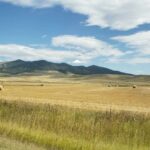
-
Montana is a mix of agriculture and steep hills.
-
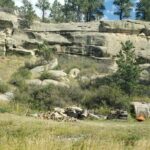
-
Tenting among rocks.
-
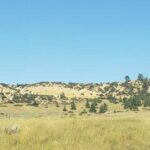
-
Montana’s varied landscape
American Praririe Reserve
We headed west and then north on US 191 to our cabin on the American Prairie Reserve (APR). Small cabins with bunk beds and storage space were seven miles north of the Missouri River. Although we have tent camped many times in bear and cougar country, we were glad to have a rustic cabin. Along with four cabins, there were also about twelve primitive camping sites. We cooked outside.
The well for potable water, with high mineral content, was 2,000 feet deep. We used community showers, toilets, two sinks, and a dishwashing sink/drainer which were very thoughtfully spaced and planned. By hiking trails near the cabins, we learned about prairie ecosystems – grasslands, soil and water, bugs, birds, and animals. As we hiked around the area, prairie dogs gave us hell every time, pipping like crazy. Plenty of scat and some bear paw prints confirmed we were glad to have a cabin to stay in.
-
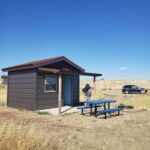
-
Several huts and rustic camp spots invited visitors.
-

-
The tiny cabin kept us warm.
-
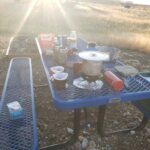
-
We cooked outside.
Little Rockies in the north in this photo. The Lewis and Clark Expedition thought they were the Rockies.
Other trails lace the Reserve. The Upper Missouri River Breaks are west and the Charles M. Russell Wildlife Refuge is south of the American Prairie Reserve with trails.
The evenings were delightful. Gorgeous sunsets glowed for hours. And in the dark sky, a jillion stars shone brightly. We saw constellations we hadn’t seen in years.
-
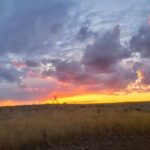
-
Sunsets linger in the open West.
-
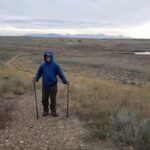
-
Beginning of the Rockies.
-
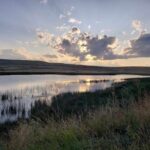
-
Birds flock to wetlands.
Munching in Malta Montana
We enjoyed the tiny, totally packed general store in Zortman hamlet. (3-4 of everything!) We circled the Bowdoin National Wildlife Refuge, a treasure of lakes and wetlands. Here is a sanctuary for resident and migratory birds, many new to us. The water in the area is managed to maintain the lakes and an abundance of artificial islands were established to protect the nesting birds from predators. Stretch’s Pizza in Malta, MT, offered up some of the best vegetarian pizza ever. A welcome change from camp food and one of only two restaurant meals of our trip. The comprehensive Phillips County Museum in Malta gave major space with empathetic attention to both Native people and settlers. Absolutely a not-to-miss stop. And, of course, there was Elvis, the dinosaur, so named because of its perfectly articulated hips, found near Malta.
-

-
Montana houses many ancient artifacts.
-
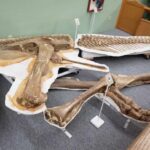
-
The hips swivel like Elvis
After three days at and near APR we headed up to US Highway 2 and Fort Peck. Again, our National Passes helped with expenses. A lovely camping spot below the dam along the Missouri River boasts trails in every direction.
Fort Peck
Fort Peck Dam is the largest hydraulic earth fill dam in the world, producing a billion kilowatts of electricity each year. You read it right, one billion. It was built in about seven years during the Great Depression but hydroelectric production didn’t get started until the early 1950s. It is 21,000 feet long.
-
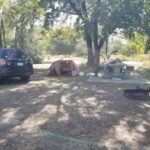
-
Trails radiate out from the campground.
-
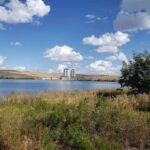
-
Billion kilowatt production
All along the Missouri River from the Breaks to Fort Peck area and around the reservoir is the Charles M. Russell Wildlife Refuge. It has sizable bison/buffalo herds. North of US Hwy 2 and east of the dam is the Fort Peck Indian Reservation where about 800 buffalo roam. We saw antelope, occasionally one but usually up to seven grazing in fields along with the cattle. American Prairie Reserve has the goal of preserving up to 300,000 acres of grassland in Montana which has one of only four sustainable grassland ecosystems in the world. The Reserve staff work with farmers to install wildlife-friendly fences, which have a more flexible, non-barbed wire on the bottom for antelope to cross under safely.
Into the Dakotas
Next, we headed east to North Dakota, and an unusually named town, Home on the Range. Every mile was a feast for the eyes as we drove through the Painted Canyon in Theodore Roosevelt National Park (TRNP) before heading to the south camping unit.
-
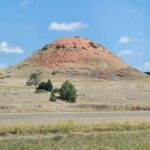
-
Western North Dakota sports splendid colors.
-
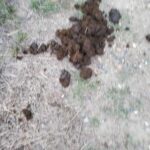
-
Animal droppings
-
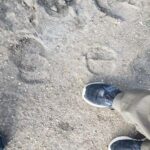
-
compare the sizes!
-

-
Bison make themselves known.
We managed to snag one of the last two camping spots. The wild horses, buffalo, antelope, and elk can all venture into the camping area. We saw evidence of the first two right near our camping spot. Five of the horses thought they might make a visit but campers steered them back into the wilds.
On our way to hike the Paddock Rim trail in the morning, we passed Sagamore Hill, Teddy Roosevelt’s Summer White House. Wild horses grazed in the distance. Bruce compared his foot size to buffalo hoof prints.
Prairie dog towns stretched as far as the eye could see in all directions. These chubby critters were grazing away, fattening up, and storing food for the winter as they do not hibernate. They were less wary than the ones on the American Prairie Reserve.
Agriculture and Open Range
As we drove through Montana, North Dakota, and northern South Dakota, I could not believe how many hay bales in fields and the enormous stacks and rows of bales we saw. We understand they had an unusually rainy summer and so the harvest was plentiful and they will be selling a lot of hay south. We also saw many cattle storm shelters on the ranches, and huge corners of metal or wood on the west and north for cattle to shelter if they get caught in the field during snowstorms. Here is a stock image of a shelter. The ones we saw were 2-4 times this big on a side to shelter a large herd and probably some wildlife, too.
-
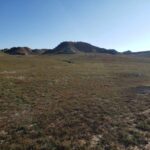
-
Prairie Dogs
-
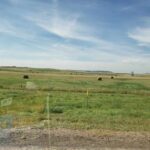
-
Enormous hay bales
-
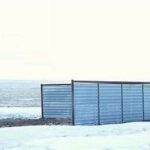
-
Cattle can huddle in the enclosures in bad storms.
Black Hills
On south to the Black Hills where we camped near Deadwood with the hills behind and mule deer in the campground.
The next day we circled lovely Sylvan Lake which was one of Bruce’s Aunt Gertrude’s favorite spots.
Having seen Rushmore several times with Gertrude, we chose the Needles Highway with plenty of crazy drivers.
Custer Park carefully maintains a herd of about 1400 buffalo so the land is not overgrazed. We visited the buffalo center and learned a mountain of new information and met “Bob” the buffalo.
-
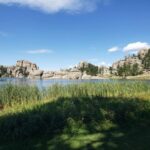
-
A favorite spot in the Black Hills
-
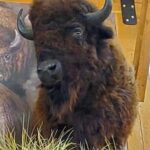
-
Custer State Park maintains a herd of bison
-
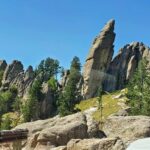
-
spires of the Needles Highway
We headed south to Wind Cave National Park to camp and saw buffalo coming down the hill as we ate supper. With an approaching storm perhaps they were heading to shelter.
Our camp was somewhat sheltered by a hill but we endured the most vivid storm with constant lightning and thunder, and pounding rain we have ever experienced in our tent. Not the windiest but certainly the loudest and most vivid. Obviously, we survived and surprisingly stayed dry. Running to the car would have been deadly.
-
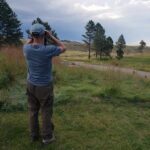
-
A fierce storm sent bison to shelter
-
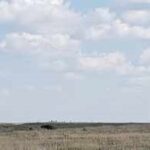
-
Bison
-
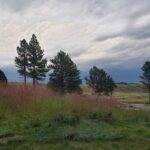
-
Storms kick up quickly in the west.
Our last camping spot before we headed to our farm was on the Niobrara River at Smith Falls State Park near Valentine, Nebraska. What a lovely night with the river rippling by. Smith Falls, is privately owned. However, the owner put in his will a permanent lease to the state so that visitors could experience this treasure. The hike and falls are quite stunning and the state has ensured that anyone can access this special place — totally handicapped accessible.
-
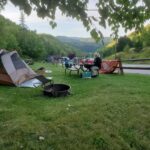
-
Most meals we prepared in camp.
-
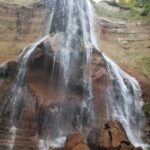
-
This private falls is open to the public.
-
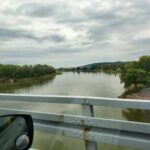
-
We followed and crossed the Missouri River many times.
So, we arrived back in Iowa, realizing we had seen many sections of the Missouri River along the way.
by Winding Pathways | Sep 7, 2023 | (Sub)Urban Homesteading, Chickens, Garden/Yard
What’s Egg Color Got to Do With It?
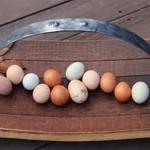
An array of jewels. Photo by Lisa Ramlo.
Are brown-shelled eggs better than white-shelled ones? Supermarkets sell all sorts of eggs. Brown or white shell. Free range or not. Organic. Vegan. Prices per dozen vary greatly. How is a consumer supposed to buy the freshest and tastiest egg?
We’ve been raising chickens for decades and have kept hens that lay white, brown, and even blue and green-shelled eggs. All are laid by birds of the very same species. The nutritional value of an egg is the same no matter what its shell color. Taste varies depending on how fresh the egg is and what the hen ate. It is independent of shell color.
Brown Eggs: Most supermarket brown eggs are laid by hybrid hens, often called ISA Browns. These were developed from the somewhat large Rhode Island Red breed. They may be raised in cages in enormous factory farms or come from a smaller free-range flock. Brown-shelled eggs may be free-range or organic……or not.
White Eggs: Almost all supermarket white eggs are laid by White Leghorn hybrids. They are smaller-bodied hens than brown egg layers and are commonly raised in cages in enormous chicken factory farms.
Blue or Green Eggs: Rarely seen in supermarkets, these beautiful eggs are laid by the Araucana breed or hybrids developed from them. These hens are common in backyard flocks.
Organic: If labeled organic the hens are supposed to have been fed feed raised according to organic standards. Eggs marked vegan or natural may or may not be organic. Be wary of vegan eggs, as hens are omnivores. If they encounter insects, worms or meat scraps they’ll readily devour them.
Cage Free: The hens that laid these eggs normally are crammed into a large building but are not confined to the tight space of a cage. They may, or may not, have access to the outdoors.
Free Range: This is tricky. Supposedly free-range hens have ready access to the outdoors, but there may be only a tiny outdoor run for thousands of hens to enjoy.
How To Tell If Eggs Are Fresh

Store-bought eggs are a pale yellow with runny whites. Fresh eggs radiate a golden hue centered in a firm albumen.
Nearly all egg cartons claim that the eggs inside are fresh, but what does that mean? They could have been laid six weeks earlier. To tell if an egg is fresh, fill a deep bowl with water and gently put an egg on the surface. If it sinks it’s reasonably fresh. If it floats it’s old. The reason is, a fresh egg has a small air cell. As it ages, moisture leaves through the porous shell and the air cell grows, making the egg buoyant.
The white, or albumen, of a fresh egg, will be relatively deep when cracked into the frying pan. It will spread out widely and be flat in an old egg.
How to Tell if Hens are Truly Pastured Raised
Most commercial eggs come from hens fed a specially prepared diet that provides all the nutrients they need but little else. The eggs will have pale yolks. In contrast eggs laid by hens with ready access to green vegetation will lay eggs with deep orange or yellow yolks. Some premium chicken feeds include marigold petals that impart deep color to the yolks.
Choosing the Highest Quality Eggs
It may take buying several dozen differently marketed eggs to find the freshest, tastiest, and most attractive eggs. Although the least expensive eggs usually come from factory farms, the best eggs aren’t always the most expensive. The very best will be fresh and have a boldly colored yolk.
For information on chicken breeds scan the Hoover’s Hatchery Website . For general information on eggs and recipes check out the website of the Egg Industry Center.
















































